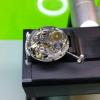-
Recently Browsing
- No registered users viewing this page.
-
Topics
-
Posts
-
By Terrinecold · Posted
@caseback indeed. I'll check the exact dimension tonight -
Whatever method or level you decide to take it too, can I suggest when you get there you put 3-4 thin coats of renaissance wax on it and buff it well. This will give a good protection against finger marks and oxidising in the future. Tom
-
By rjenkinsgb · Posted
That looks familiar! I was recently given one with a very similar state case - but yours is not as bad as mine! I was advised the one I have had a gunmetal case and was supposed to have a blued finish - the inside back cover, the blue-black, is what the outside should be. To see if it is gunmetal or pewter, see if a magnet is attracted when near it, but I'd remove the movement first and demagnetise afterwards. This is the one I did, as much an experiment as a definite solution; just don't use the boiling part, as this did not do anything useful other than wreck the old pan I used. The cracks in an enamelled dial can apparently be made invisible with denture cleaner, though I've not tried that myself. -
if you're in watch repair long enough you'll find all sorts of strange and interesting things. unfortunately this morning I can't quite remember a very peculiar Seiko I once worked on. I was working in a shop in downtown Seattle and in the early days all the watch stuff was basically around one particular part of the city and the raw so within basically across the street from each other three watch material houses. It made it really easy to get parts when you're doing watch work psychiatric quite remember the peculiar Seiko watch where the movement went into a plastic ring and I think it was sandwiched between one or two pieces of the metal case. The crown fit on a plastic tube that was part of the ring so basically it's all destroyed disassembly you had to have a brand-new one to put it back together. so I went downstairs and asked and got one plastic I think was called the gasket even though it was rigid plastic with the tube for the crown. How do curiosity I remember asking and he had a whole bag of them at least 100 of them slim must've been popular at one time. But it does bring up the problem of unusual cases with unusual things that they probably didn't makewhatever this was called forever which means you'd never build a put the watch back together today.
-
By rjenkinsgb · Posted
Acetone is a pretty good solvent degreaser for metal parts, and is rather safer than either naphtha or benzine, as small amounts are naturally produced and metabolised in the body. Just keep it away from most plastics & finishes! (OSHA limits for a eight hour exposure: Acetone 1000ppm, Heptane 500ppm, Benzine/Light naphtha 350ppm, Naphtha 100ppm). Naphtha (the 100ppm one) can contain trace amounts of Benzene, which is a carcinogen. [I used the US standards as Naphtha is not generally listed in the UK documents & I wanted all data from the same source].
-








Recommended Posts
Join the conversation
You can post now and register later. If you have an account, sign in now to post with your account.
Note: Your post will require moderator approval before it will be visible.